Nguyễn Công Phương
Sensors and Analytical Devices
Some Basic Measurement Methods, Flow Measurement
Contents
A. Introduction B. Sensors Characteristics C. Some Basic Measurement Methods D. Measurement Systems
sites.google.com/site/ncpdhbkhn 2
Some Basic Measurement Methods
I. Sensor Technologies II. Temperature Measurement III. Pressure Measurement IV.Flow Measurement V. Level Measurement VI.Mass, Force, and Torque Measurement VII.Translational Motion, Vibration, and Shock
Measurement
VIII.Rotational Motion Transducers
sites.google.com/site/ncpdhbkhn 3
Flow Measurement
1. Introduction 2. Mass Flow Rate 3. Volume Flow Rate 4. Choice between Flowmeters
sites.google.com/site/ncpdhbkhn 4
Introduction (1)
• Flow measurement is to quantify the rate of flow of
materials. It is quite a common requirement in the process industries.
• • The materials measured may be in a solid, liquid, or
gaseous state.
• Solid state: flow can only be qualified as the mass flow rate. • Mass flow rate: the mass of material that flows in one unit
of time.
• Liquid or gaseous state: flow can be qualified as either the
mass flow rate or the volume flow rate.
• Volume flow rate: the volume of material that flows in one
unit of time.
• Note: mass is invariant, whereas volume is a variable
quantity.
sites.google.com/site/ncpdhbkhn 5
Introduction (2)
• A particular complication in the measurement of flow rate of liquids &
gases flowing in pipes: the need to consider whether the flow is laminar or turbulent. • Laminar flow:
– A motion of the fluid being in a direction parallel to the sides of the pipe. – It occurs in straight lengths of pipe when the fluid is flowing at a low velocity. – Note that even laminar flow is not uniform across the cross section of the pipe: the
velocity is greatest at the center of the pipe, & decreases to zero immediately next to the wall of the pipe.
• Turbulent flow:
– A complex pattern of flow that is not in a uniform direction. – Occurs in nonstraight sections of pipe & also occurs in straight sections when the fluid
velocity exceeds a critical value.
– Difficult to measure.
• The usual practice is to restrict flow measurement to places where the flow
is laminar, or at least approximately laminar – Measure the flow in the center of a long, straight length of pipe if the flow velocity is
– If the mean fluid velocity is high, it is often possible to find somewhere within the flow
Turbulent
below the critical value for turbulent flow. Laminar path where a larger diameter pipe exists & therefore the flow velocity is lower. http://blog.nialbarker.com/252/slow_is_faster
sites.google.com/site/ncpdhbkhn 6
Flow Measurement
1. Introduction 2. Mass Flow Rate
a) Conveyor-Based Methods b) Coriolis Flowmeter c) Thermal Mass Flow Measurement
3. Volume Flow Rate 4. Choice between Flowmeters
sites.google.com/site/ncpdhbkhn 7
Conveyor-Based Methods
http://www.conveyorbeltguide.com/ ConveyorSafetyDevices.html
• Appropriate for measuring the flow of solids in the form of powders or
small granular particles.
• A conveyor is a very suitable means of transporting materials in this form. • Transporting materials on a conveyor allows the mass flow rate to be
calculated in terms of the mass of material:
Q = Mv/L
– Q: the mass flow rate – M: the mass of material distributed over a length, L, of the conveyor – v: the velocity of the conveyor
sites.google.com/site/ncpdhbkhn 8
Coriolis Flowmeter
• Dominates the mass flowmeter market. • Consists either of a pair of parallel vibrating
tube or as a single vibrating tube that is formed into a configuration that has two parallel sections.
• Tubes are commonly made of stainless steel. • The two vibrating tubes deflect according to
http://en.wikipedia.org/wiki/Mass_fl ow_meter#Operating_principle_of_ a_coriolis_flow_meter
the mass flow rate of the measured fluid that is flowing inside:
d = kfR
– d: the net deflection – k: a constant – f: the frequency of the tube vibration – R: the mass flow rate • Excellent accuracy: ±0.2% • Low maintenance requirements • Expensive •
Failure may occur after a period of use because of mechanical fatigue in the tube. • Tubes are also subject to corrosion.
sites.google.com/site/ncpdhbkhn 9
Thermal Mass Flow Measurement
• Used primarily to measure the flow
rate of gases.
• The principle of operation is to
direct the flowing material past a heated element.
• The mass flow rate is inferred in
two ways: – by measuring the temperature rise in the flowing material, or – by measuring the heater power required to achieve a constant set temperature in the flowing material. Inaccuracy: ±2%
• • Can measure very small flow rates:
10–9 liters per minute.
http://www.azosensors.com/article.aspx? ArticleID=277
sites.google.com/site/ncpdhbkhn 10
Flow Measurement
Introduction 1. 2. Mass Flow Rate 3. Volume Flow Rate
a) Differential Pressure (Obstruction-Type) Meters b) Variable Area Flowmeters (Rotameters) c) Positive Displacement Flowmeters d) Turbine Meters e) Electromagnetic Flowmeters f) Vortex-Shedding Flowmeters g) Ultrasonic Flowmeters h) Other Types of Flowmeters for Measuring Volume Flow
Rate
i) Open Channel Flowmeters 4. Choice between Flowmeters
sites.google.com/site/ncpdhbkhn 11
Differential Pressure (Obstruction-Type) Meters (1)
Involve the insertion of some device into a fluid-carrying pipe. • • This device causes an obstruction & creates a pressure difference on
either side of the device.
• Devices: orifice place, Venturi tube, flow nozzle, & Dall flow tube. • When such a restriction is placed in a pipe, the velocity of the fluid
through the restriction increases & the pressure decreases. • The volume flow rate is proportional to the square root of the
pressure difference across the obstruction.
• The normal procedure is to use a differential pressure transducer,
which is commonly a diaphragm-type device.
• The pitot static tube:
– Another device that measures flow by creating a pressure difference
within a fluid-carrying pipe.
– However, there is negligible obstruction of flow in the pipe. – The pitot tube is a very thin tube that obstructs only a small part of the flowing fluid & thus measures at a single point across the cross section of the pipe.
sites.google.com/site/ncpdhbkhn 12
Differential Pressure (Obstruction-Type) Meters (2)
http://www.piping- engineering.com/restriction-orifice-ro- flow-control-instrument.html
Orifice plate
Segmental Orifice Plate
http://sageoilfield.com/page.php?page=292 sites.google.com/site/ncpdhbkhn 13
Differential Pressure (Obstruction-Type) Meters (3)
• The orifice plate is a metal disc with a hole on
•
it. Inserted into the pipe carrying the flowing fluid.
• Simple, inexpensive, available in a wide range
of sizes.
• Account for almost 50% of the instruments used in industry for measuring volume flow rate. • Problems:
– Inaccuracy: at least ±2% – Permanent pressure loss: 50 to 90% of
(P1 – P2)
– A gradual change in the sharp edges of the
hole: it wears away
– Particles tend to stick behind the hole. • To minimize pressure loss: Venturi, flow
Segmental Orifice Plate
nozzle, & Dall flow tube.
http://sageoilfield.com/page.php?page=292 sites.google.com/site/ncpdhbkhn 14
Differential Pressure (Obstruction-Type) Meters (4)
Venturi
http://www.stepbystep.com/difference-between- venturi-and-orifice-103728/
sites.google.com/site/ncpdhbkhn 15
Differential Pressure (Obstruction-Type) Meters (5)
• Has a precision-engineered tube of a special
shape.
• Inaccuracy: ±1% • Permanent pressure loss: 10 – 15% of (P1 – P2) • The most expensive of all the obstruction devices.
http://www.stepbystep.com/difference-between-venturi-and-orifice-103728/
sites.google.com/site/ncpdhbkhn 16
Differential Pressure (Obstruction-Type) Meters (6)
Flow nozzle
http://www.stepbystep.com/difference-between- venturi-and-orifice-103728/
sites.google.com/site/ncpdhbkhn 17
Differential Pressure (Obstruction-Type) Meters (7)
• Of simple construction less expensive than
either a Venturi or a Dall flow tube. • Pressure loss: 35 – 50% of (P1 – P2).
http://www.stepbystep.com/difference-between-venturi-and-orifice-103728/
sites.google.com/site/ncpdhbkhn 18
Differential Pressure (Obstruction-Type) Meters (8)
Dall flow tube
http://smartcontrol.blogspot.com/2012/03/flow- measurement.html
sites.google.com/site/ncpdhbkhn 19
Differential Pressure (Obstruction-Type) Meters (9)
• Consists of 2 conical reducers inserted into a fluid-carrying pipe. • Has a very similar internal shape to the Venturi, except that it lacks a throat. • Much easier to manufacture cheaper than Venturi. • •
Inaccuracy: ±1.5% Its shorter length makes the engineering task of inserting it into the flow line easier.
• Pressure loss: 5% of (P1 – P2).
http://smartcontrol.blogspot.com/2012/03/flow-measurement.html
sites.google.com/site/ncpdhbkhn 20
Differential Pressure (Obstruction-Type) Meters (10)
Pitot static tube
http://www.fekete.com/SAN/TheoryAndEquations/Field NotesTheoryAndEquations/Theory_Gas_Pitot_Tube.htm
sites.google.com/site/ncpdhbkhn 21
Differential Pressure (Obstruction-Type) Meters (11)
• Used mainly for making temporary measurements of flow. • Also used in some instances for permanent flow monitoring. • Measures the local velocity offlow at a particular point within a pipe. • May be very useful where there is a requirement to measure local flow rates across the cross section of a pipe in the case of nonuniform flow. Inexpensive, & very simple to install. Inaccuracy: ±5%.
• •
http://www.fekete.com/SAN/TheoryAndEquations/FieldNotesTheoryAndEquations/Theory_Gas_Pitot_Tube.htm
sites.google.com/site/ncpdhbkhn 22
Flow Measurement
Introduction 1. 2. Mass Flow Rate 3. Volume Flow Rate
a) Differential Pressure (Obstruction-Type) Meters b) Variable Area Flowmeters (Rotameters) c) Positive Displacement Flowmeters d) Turbine Meters e) Electromagnetic Flowmeters f) Vortex-Shedding Flowmeters g) Ultrasonic Flowmeters h) Other Types of Flowmeters for Measuring Volume Flow
Rate
i) Open Channel Flowmeters 4. Choice between Flowmeters
sites.google.com/site/ncpdhbkhn 23
Variable Area Flowmeters
• A.k.a. rotameters. • Account for about 20% of all
flowmeters sold.
• Consist of a tapered glass tube containing a float that takes up a stable position where its submerged weight is balanced by the up thrust due to the differential pressure across it. • The position of the float is to
measure the flow rate. • Reliable, inexpensive. • Inaccuracy: ±5%.
http://bgconv.com/docs/index-34707.html
sites.google.com/site/ncpdhbkhn 24
Flow Measurement
Introduction 1. 2. Mass Flow Rate 3. Volume Flow Rate
a) Differential Pressure (Obstruction-Type) Meters b) Variable Area Flowmeters (Rotameters) c) Positive Displacement Flowmeters d) Turbine Meters e) Electromagnetic Flowmeters f) Vortex-Shedding Flowmeters g) Ultrasonic Flowmeters h) Other Types of Flowmeters for Measuring Volume Flow
Rate
i) Open Channel Flowmeters 4. Choice between Flowmeters
sites.google.com/site/ncpdhbkhn 25
Positive Displacement Flowmeters
• Account for nearly 10% of the total number of
flowmeters used in industry.
• Used in large numbers for metering dosmetic gas &
water consumption.
• Inaccuracy: from ±2% (the least expensive) to ±0.5%. • The hight quality instruments are used extensively
within the oil industry.
• All use mechanical divisions to displace discrete
volumes of fluid successively.
• Low friction, low maintenance, & long life. • A small pressure loss. • Types: rotary piston meter, nutating disk meter, oval
gear meter.
sites.google.com/site/ncpdhbkhn 26
Rotary Piston Meter
http://www.trimec-fp.com.au/products/multipulse-rotary-piston-meters/
sites.google.com/site/ncpdhbkhn 27
Nutating Disk Meter
http://en.wikipedia.org/wiki/Nutating_disc_engine
sites.google.com/site/ncpdhbkhn 28
Oval Gear Meter
http://www.buygpi.com/ovalgearmeters.aspx
http://www.bellflowsystems.co.uk/oil-meters/macnaught-oval-gear-oil-fuel-meters/
sites.google.com/site/ncpdhbkhn 29
Flow Measurement
Introduction 1. 2. Mass Flow Rate 3. Volume Flow Rate
a) Differential Pressure (Obstruction-Type) Meters b) Variable Area Flowmeters (Rotameters) c) Positive Displacement Flowmeters d) Turbine Meters e) Electromagnetic Flowmeters f) Vortex-Shedding Flowmeters g) Ultrasonic Flowmeters h) Other Types of Flowmeters for Measuring Volume Flow
Rate
i) Open Channel Flowmeters 4. Choice between Flowmeters
sites.google.com/site/ncpdhbkhn 30
Turbine Meters
• Consist of a multibladed wheel
mounted in a pipe along an axis parallel to the direction of fluid flow in the pipe.
• The flow of fluid past the wheel causes it to rotate at a rate proportional to the volume flow rate of the fluid. • The turbine blades are made of a
ferromagnetic material.
http://www.bellflowsystems.co.uk/ turbine-flow-meters/
• When the turbine wheel moves past an external coil, it induces a voltage pulse in the coil. Inaccuracy: ±0.2%.
• • Less rugged & reliable than flow restriction-type instruments.
• Bearing wear is a particular problem.
sites.google.com/site/ncpdhbkhn 31
Flow Measurement
Introduction 1. 2. Mass Flow Rate 3. Volume Flow Rate
a) Differential Pressure (Obstruction-Type) Meters b) Variable Area Flowmeters (Rotameters) c) Positive Displacement Flowmeters d) Turbine Meters e) Electromagnetic Flowmeters f) Vortex-Shedding Flowmeters g) Ultrasonic Flowmeters h) Other Types of Flowmeters for Measuring Volume Flow
Rate
i) Open Channel Flowmeters 4. Choice between Flowmeters
sites.google.com/site/ncpdhbkhn 32
Electromagnetic Flowmeters (1)
• A.k.a. magnetic flowmeters. • Are limited to measuring the volume flow rate of electrically conductive fluids. • Consist of a stainless-steel cylindrical tube fitted with an insulating liner, which
carries the measured fluid.
• A magnetic field is created in the tube by magnetic field coils placed either side of
the tube.
• The voltage induced in the fluid is measured by two electrodes inserted into
opposite sides of the tube.
• The end of these electrodes are usually flush with the inner surface of the cylinder. • By Faraday’s law of electromagnetic induction:
U = BDv
http://cclynchblog.com/fundamentals-of- electromagnetic-flow-meters-grounding/
sites.google.com/site/ncpdhbkhn 33
Electromagnetic Flowmeters (2)
• Inaccuracy: ±1% • Expensive:
– The electrodes (titanium, tantalum, etc.), – Running costs (electricity consumption), – The need for careful calibration of each instrument
individually during manufacture.
• Account for 15% of the new flowmeters sold. • Problem: the insulating lining is subject to
damage when abrasive fluids are being handled.
• Battery-powered versions are now available
commercially.
sites.google.com/site/ncpdhbkhn 34
Flow Measurement
Introduction 1. 2. Mass Flow Rate 3. Volume Flow Rate
a) Differential Pressure (Obstruction-Type) Meters b) Variable Area Flowmeters (Rotameters) c) Positive Displacement Flowmeters d) Turbine Meters e) Electromagnetic Flowmeters f) Vortex-Shedding Flowmeters g) Ultrasonic Flowmeters h) Other Types of Flowmeters for Measuring Volume Flow
Rate
i) Open Channel Flowmeters 4. Choice between Flowmeters
sites.google.com/site/ncpdhbkhn 35
Vortex-Shedding Flowmeters
• Used as an alternative to traditional differential pressure meters in many
applications.
• Based on the natural phenomenon of vortex shedding, created by placing an
unstreamlined obstacle (bluff body) in a fluid-carrying pipe.
• The shedding frequency of these alternately shed vortices is proportional to the
fluid velocity past the body.
• Various thermal, magnetic, ultrasonic, & capacitive vortex detection techniques are
employed in different instruments.
• Have no moving parts, operate over a wide flow range, have low power
consumption, require little maintenance, low cost.
Inaccuracy: ±1%. Problem: susceptible to pipe vibrations.
• Can measure both liquid & gas flows. • •
http://www.instrumart.com/pages/ 230/vortex-shedding-flow-meters
sites.google.com/site/ncpdhbkhn 36
Flow Measurement
Introduction 1. 2. Mass Flow Rate 3. Volume Flow Rate
a) Differential Pressure (Obstruction-Type) Meters b) Variable Area Flowmeters (Rotameters) c) Positive Displacement Flowmeters d) Turbine Meters e) Electromagnetic Flowmeters f) Vortex-Shedding Flowmeters g) Ultrasonic Flowmeters h) Other Types of Flowmeters for Measuring Volume Flow
Rate
i) Open Channel Flowmeters 4. Choice between Flowmeters
sites.google.com/site/ncpdhbkhn 37
Ultrasonic Flowmeters
• A noninvasive method. • Particularly useful for measuring the flow of corrosive
fluids & slurries.
• Advantages:
– High reliability & low maintenance requirements. – Can be clamped externally onto existing pipe work
instead of being inserted as an integral part of the flow line low cost & safety
– Any contamination of the fluid being measured (e.g.,
food & drugs) is avoided.
• Still less common than differential pressure or
electromagnetic flowmeters.
• Types: Doppler shift & transit time.
sites.google.com/site/ncpdhbkhn 38
Doppler Shift Ultrasonic Flowmeter (1)
http://mandi2008.mam9.com/t218-topic
• A fundamental requirement of these instruments is the
presence of scattering elements within the flowing fluid. • These elements deflect the ultrasonic energy output from
the transmitter such that it enters the receiver.
• Elements: solid particles, gas bubles. • These elements cause a frequency shift between transmitted
& reflected ultrasonic energy.
sites.google.com/site/ncpdhbkhn 39
Doppler Shift Ultrasonic Flowmeter (2) • Consists essentially of an ultrasonic transmitter – receiver pair clamped
onto the outside wall of a fluid-carrying vessel.
• Ultrasonic energy consists of a train of short bursts of sinusoidal
waveforms at frequency between 0.5 & 20 MHz.
• The flow velocity:
v = f(ftransmitted wave , freceived wave , vsound in fluid)
• The electronics involved is relatively simple inexpensive. •
Inaccuracy: – Depends on the flow profile; the constancty of pipe wall thickness; the number, size, & spatial distribution of scatterers; the accuracy of determined velocity of sound in the fluid. – Can approach ±10%
• Often used merely as flow indicators rather than for accurate quantification. • For versions that are fitted inside the flow rate:
– Overcome the problem of variable pipe thickness – Inaccuracy: ±0.5%
sites.google.com/site/ncpdhbkhn 40
Transit Time Ultrasonic Flowmeter (1)
• An instrument designed for measuring the volume flow
rate in clean liquids or gases.
• Consists of a pair of ultrasonic transducers mounted
along an axis aligned at angle θ with respect to the fluid flow axis.
• Each transducer consists of a transmitter-receiver pair. • The transmitter emits ultrasonic energy that travels
across to the receiver on the opposite side of the pipe.
http://www.efunda.com/des ignstandards/sensors/flowm eters/flowmeter_ustt.cfm
sites.google.com/site/ncpdhbkhn 41
Transit Time Ultrasonic Flowmeter (2)
• Fluid flowing in the pipe causes a time difference
between the transit times of beams traveling upstream & downstream.
• Measurement of this difference allows the flow velocity
to be calculated.
• The typical magnitude of this time difference is 100 ns
in a total transit time of 100 μs.
• High-precision electronics are required to measure the
difference.
http://www.efunda.com/des ignstandards/sensors/flowm eters/flowmeter_ustt.cfm
sites.google.com/site/ncpdhbkhn 42
Transit Time Ultrasonic Flowmeter (3)
• 3 ways to measure the time shift:
– Direct measurement (speed of sound is required) – Conversion to a phase change (speed of sound is required) – Conversion to a frequency change (speed of sound is NOT
required)
• Transit time flowmeter is of more general use than
Doppler shift flowmeters.
• Inaccuracy: ±0.5%. • More expensive than a Doppler shift flowmeter.
http://www.efunda.com/des ignstandards/sensors/flowm eters/flowmeter_ustt.cfm
sites.google.com/site/ncpdhbkhn 43
Flow Measurement
Introduction 1. 2. Mass Flow Rate 3. Volume Flow Rate
a) Differential Pressure (Obstruction-Type) Meters b) Variable Area Flowmeters (Rotameters) Positive Displacement Flowmeters c) Turbine Meters d) Electromagnetic Flowmeters e) f) Vortex-Shedding Flowmeters g) Ultrasonic Flowmeters h) Other Types of Flowmeters for Measuring Volume Flow Rate
Gate-Type Meter i. Jet Meter ii. Laser Doppler Flowmeter iii. Thermal Anemometers iv. Open Channel Flowmeters
i)
4. Choice between Flowmeters
sites.google.com/site/ncpdhbkhn 44
Gate-Type Meter, Air Vane Meter
http://www.youtube.com/ watch?v=Xkyfjo7spFc
• Measures deflection of the flap. • Used to measure airflow within automotive
fuel – injection systems.
sites.google.com/site/ncpdhbkhn 45
Gate-Type Meter, Target Meter
http://jhhdyb.en.ec21.com/ Target_Type_Flow_Meter-- 4686355_4687565.html
• Consists of a circular, disc-shaped flap in the pipe. • Fluid flow rate is inferred from the force exerted on the disc
measured by strain gauges bonded to it.
• Very useful for measuring the flow of dilute slurries. • Rather expensive.
sites.google.com/site/ncpdhbkhn 46
Flow Measurement
Introduction 1. 2. Mass Flow Rate 3. Volume Flow Rate
a) Differential Pressure (Obstruction-Type) Meters b) Variable Area Flowmeters (Rotameters) Positive Displacement Flowmeters c) Turbine Meters d) Electromagnetic Flowmeters e) f) Vortex-Shedding Flowmeters g) Ultrasonic Flowmeters h) Other Types of Flowmeters for Measuring Volume Flow Rate
Gate-Type Meter i. Jet Meter ii. Laser Doppler Flowmeter iii. Thermal Anemometers iv. Open Channel Flowmeters
i)
4. Choice between Flowmeters
sites.google.com/site/ncpdhbkhn 47
Jet Meter
http://www.enggcyclopedia.com/2011/07/mechanical-flow-measurement-devices/
sites.google.com/site/ncpdhbkhn 48
Laser Doppler Flowmeter (1)
• Gives direct measurements of flow velocity for liquids
containing suspended particles flowing in a pipe.
• Light from a laser is focused by an optical system to a point
in the flow.
• The movement of particles causes a Doppler shift of the
scattered light & produces a signal in a photo detector that is related to the fluid velocity. • Range: from 10 μm/s to 105 m/s.
http://www.efunda.com/des ignstandards/sensors/laser_ doppler/laser_doppler_flow _theory.cfm
sites.google.com/site/ncpdhbkhn 49
Laser Doppler Flowmeter (2)
• Sufficient particles for satisfactory operation are normally present naturally in most liquid & gaseous fluids the introduction of artificial particles is rarely needed.
• Advantages:
– Measures flow velocity directly, rather than inferring it
from a pressure difference.
– Causes no interruption in the flow. – The instrument can be made very small it can measure
velocity in confined areas.
• Disadvantage: it measures local flow velocity in the vicinity of the focal point of the light beam can lead to large errrors if the flow profile is not uniform.
• Main application: measuring blood flow in medical
applications.
sites.google.com/site/ncpdhbkhn 50
Flow Measurement
Introduction 1. 2. Mass Flow Rate 3. Volume Flow Rate
a) Differential Pressure (Obstruction-Type) Meters b) Variable Area Flowmeters (Rotameters) Positive Displacement Flowmeters c) Turbine Meters d) Electromagnetic Flowmeters e) f) Vortex-Shedding Flowmeters g) Ultrasonic Flowmeters h) Other Types of Flowmeters for Measuring Volume Flow Rate
Gate-Type Meter i. Jet Meter ii. Laser Doppler Flowmeter iii. Thermal Anemometers iv. Open Channel Flowmeters
i)
4. Choice between Flowmeters
sites.google.com/site/ncpdhbkhn 51
Thermal Anemometers
http://www.directindustry.com/prod/ahlborn/thermo-anemometers-17042-509709.html
• To measure the volume flow rate of gases in pipes. • Consists of a piece of thin (typical diameter 5μm), electrically heated wire (usually tungsten, platinum-iridium alloy) inserted into the gas flow.
• The flowing gas has a cooling effecton the wire, which reduces its resistance. • Measurement of resistance change allows the volume flow rate of the gas to
be calculated. • Advantages:
– Very fast speed of response an ideal instrument in conditions where the flow
velocity is changing.
– Insensitive to the direction of gas flow very useful device in conditions of
turbulent flow.
• Disadvantage: not robust because of the very small diameter of the wire. sites.google.com/site/ncpdhbkhn
http://www.alnorcanada.com /alnor-velometer-thermal- anemometers.htm
52
Flow Measurement
Introduction 1. 2. Mass Flow Rate 3. Volume Flow Rate
a) Differential Pressure (Obstruction-Type) Meters b) Variable Area Flowmeters (Rotameters) c) Positive Displacement Flowmeters d) Turbine Meters e) Electromagnetic Flowmeters f) Vortex-Shedding Flowmeters g) Ultrasonic Flowmeters h) Other Types of Flowmeters for Measuring Volume Flow
Rate
i) Open Channel Flowmeters 4. Choice between Flowmeters
sites.google.com/site/ncpdhbkhn 53
Open Channel Flowmeters
• Measure the flow of liquids in
open channels & are particularly relevant to measuring the flow of water in rivers as part of environmental management schemes.
• 2 methods:
– Build a weir on constant width across the flow & measure the velocity of flow & the height of liquid immediately before the weir.
– If the flow is conductive, 2 or more electromagnetic meters can be placed side by side to measure the flow velocity.
http://www.controlelectronics.com/ 360PrimDev.html
sites.google.com/site/ncpdhbkhn 54
Flow Measurement
1. Introduction 2. Mass Flow Rate 3. Volume Flow Rate 4. Choice between Flowmeters
sites.google.com/site/ncpdhbkhn 55
Choice between Flowmeters
• The number of relevant factors to be considered when specifying a
flowmeter for a particular application is very large: – Temperature, pressure, density, viscosity, chemical properties &
abrasiveness, whether it contains particles, whether it is a liquid or gas, etc.
– Accuracy, range, acceptable pressure drop, output signal characteristics,
reliability, service life.
– Purchase cost, installation difficulties, maintenance requirements,
service life.
• Where only a visual indication of flow rate is needed, the variable
are meter is popular.
• Where a flow measurement in the form of an electrical signal si
required, the choice is very large.
• The orifice plate is used extremely commonly, accounting for almost
50% of instruments currently in use in industry.
• Other forms of differential pressure meters & electromagnetic
flowmeters are used in large numbers.
sites.google.com/site/ncpdhbkhn 56

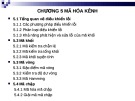

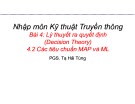
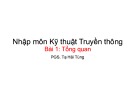



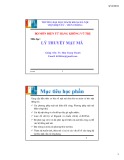
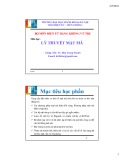
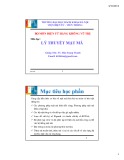
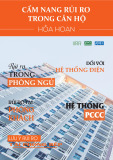
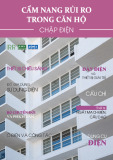











![Bộ tài liệu Đào tạo nhân viên chăm sóc khách hàng tại đơn vị phân phối và bán lẻ điện [Chuẩn nhất]](https://cdn.tailieu.vn/images/document/thumbnail/2025/20251001/kimphuong1001/135x160/3921759294552.jpg)

